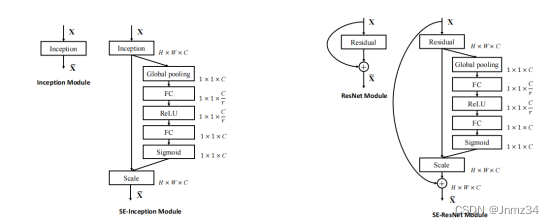### 回答1:
示例代码:import torch
import torch.nn as nn class SENet(nn.Module):
def __init__(self, in_channels, out_channels):
super(SENet, self).__init__()
self.conv1 = nn.Conv2d(in_channels, out_channels, 3, padding=1)
self.se_block = nn.Sequential(
nn.Linear(out_channels, out_channels // 16),
nn.ReLU(),
nn.Linear(out_channels // 16, out_channels)
)
self.relu = nn.ReLU()
self.conv2 = nn.Conv2d(out_channels, out_channels, 3, padding=1)
def forward(self, x):
x = self.conv1(x)
x = self.se_block(x)
x = self.relu(x)
x = self.conv2(x)
return x
### 回答2:
import torch
import torch.nn as nn
# 定义SENet模块中的Squeeze-and-Excitation块
class SEBlock(nn.Module):
def __init__(self, in_channels, reduction_ratio):
super(SEBlock, self).__init__()
self.pool = nn.AdaptiveAvgPool2d(1)
self.fc = nn.Sequential(
nn.Linear(in_channels, in_channels // reduction_ratio),
nn.ReLU(inplace=True),
nn.Linear(in_channels // reduction_ratio, in_channels),
nn.Sigmoid()
)
def forward(self, x):
b, c, _, _ = x.size()
inputs = x
x = self.pool(x).view(b, c)
x = self.fc(x).view(b, c, 1, 1)
return inputs * x
# 定义SENet网络模型
class SENet(nn.Module):
def __init__(self, num_classes=1000, reduction_ratio=16):
super(SENet, self).__init__()
self.num_classes = num_classes
self.reduction_ratio = reduction_ratio
self.conv1 = nn.Conv2d(3, 64, kernel_size=3, stride=2, padding=1, bias=False)
self.bn1 = nn.BatchNorm2d(64)
self.relu = nn.ReLU(inplace=True)
self.conv2 = nn.Conv2d(64, 64, kernel_size=3, stride=1, padding=1, bias=False)
self.bn2 = nn.BatchNorm2d(64)
self.pool = nn.MaxPool2d(kernel_size=3, stride=2, padding=1)
self.layer1 = self._make_seresnet_layer(64, 64, 3)
self.layer2 = self._make_seresnet_layer(64, 128, 4, stride=2)
self.layer3 = self._make_seresnet_layer(128, 256, 6, stride=2)
self.layer4 = self._make_seresnet_layer(256, 512, 3, stride=2)
self.avgpool = nn.AdaptiveAvgPool2d(1)
self.fc = nn.Linear(512, num_classes)
def _make_seresnet_layer(self, in_channels, out_channels, num_blocks, stride=1):
layers = []
layers.append(SEBlock(in_channels, self.reduction_ratio))
for _ in range(1, num_blocks):
layers.append(nn.Conv2d(in_channels, in_channels, kernel_size=3, stride=stride, padding=1, bias=False))
layers.append(nn.BatchNorm2d(in_channels))
layers.append(nn.ReLU(inplace=True))
layers.append(SEBlock(in_channels, self.reduction_ratio))
layers.append(nn.Conv2d(in_channels, out_channels, kernel_size=3, stride=stride, padding=1, bias=False))
layers.append(nn.BatchNorm2d(out_channels))
return nn.Sequential(*layers)
def forward(self, x):
x = self.conv1(x)
x = self.bn1(x)
x = self.relu(x)
x = self.conv2(x)
x = self.bn2(x)
x = self.relu(x)
x = self.pool(x)
x = self.layer1(x)
x = self.layer2(x)
x = self.layer3(x)
x = self.layer4(x)
x = self.avgpool(x)
x = x.view(x.size(0), -1)
x = self.fc(x)
return x
# 创建SENet实例并使用
se_net = SENet(num_classes=10)
inputs = torch.randn(1, 3, 224, 224)
outputs = se_net(inputs)
print(outputs.size()) # 打印输出的结果维度,例如torch.Size([1, 10])表示输出为1个样本,有10个类别输出
### 回答3:
import torch
import torch.nn as nn
class SEBlock(nn.Module):
def __init__(self, inplanes, reduction_ratio=16):
super(SEBlock, self).__init__()
self.avgpool = nn.AdaptiveAvgPool2d(1)
self.fc = nn.Sequential(
nn.Linear(inplanes, inplanes // reduction_ratio),
nn.ReLU(inplace=True),
nn.Linear(inplanes // reduction_ratio, inplanes),
nn.Sigmoid()
)
def forward(self, x):
out = self.avgpool(x).squeeze(3).squeeze(2)
out = self.fc(out).unsqueeze(2).unsqueeze(3)
return x * out
class SENet(nn.Module):
def __init__(self, num_classes=1000):
super(SENet, self).__init__()
self.conv1 = nn.Conv2d(3, 64, kernel_size=7, stride=2, padding=3,
bias=False)
self.bn1 = nn.BatchNorm2d(64)
self.relu = nn.ReLU(inplace=True)
self.maxpool = nn.MaxPool2d(kernel_size=3, stride=2, padding=1)
self.layer1 = self._make_layer(64, 64, 3)
self.layer2 = self._make_layer(64, 128, 4, stride=2)
self.layer3 = self._make_layer(128, 256, 6, stride=2)
self.layer4 = self._make_layer(256, 512, 3, stride=2)
self.avgpool = nn.AdaptiveAvgPool2d(1)
self.fc = nn.Linear(512, num_classes)
def _make_layer(self, inplanes, planes, blocks, stride=1):
layers = []
layers.append(SEBlock(inplanes))
layers.append(nn.Sequential(
nn.Conv2d(inplanes, planes, kernel_size=3, stride=stride, padding=1,
bias=False),
nn.BatchNorm2d(planes),
nn.ReLU(inplace=True)
))
for _ in range(1, blocks):
layers.append(nn.Sequential(
nn.Conv2d(planes, planes, kernel_size=3, stride=1, padding=1,
bias=False),
nn.BatchNorm2d(planes),
nn.ReLU(inplace=True)
))
return nn.Sequential(*layers)
def forward(self, x):
x = self.conv1(x)
x = self.bn1(x)
x = self.relu(x)
x = self.maxpool(x)
x = self.layer1(x)
x = self.layer2(x)
x = self.layer3(x)
x = self.layer4(x)
x = self.avgpool(x)
x = torch.flatten(x, 1)
x = self.fc(x)
return x
model = SENet()
print(model)























 461
461











 被折叠的 条评论
为什么被折叠?
被折叠的 条评论
为什么被折叠?








